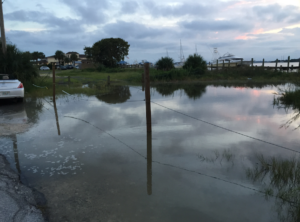By John Haughey
The Center Square
October 30, 2021

Florida’s vulnerabilities to flooding and hurricanes are increasingly well-documented and scary, especially when considering the potential economic impacts of a projected 2-foot rise in sea levels over the next quarter century.
That’s what Florida TaxWatch (FTW) does in its 56-page analysis, A Rising Tide Sinks All Homes: The Effects of Climate Change on Florida’s Economy, which assesses potential costs and consequences of climate change on 11 industries while offering a series of “strategic, multi-faceted recommendations to mitigate those impacts and ensure the state remains strong and resilient.”
“Climate change, sea-level rise, and the need for resiliency make for regular headlines, but what’s often missing from the narrative is the impact on our economy,” FTW President & CEO Dominic Calabro said in introducing the report which, among other projections, says 64,000 Florida homes representing $350 billion in taxable value would be uninhabitable if that 2-foot sea rise occurs.
“The impacts of a changing climate translate into real economic repercussions,” he continued. “If bankers and insurers won’t secure the 40% of residential properties and 35%t of commercial properties at risk of chronic flooding in Florida and they then come off property tax rolls, our communities will be impacted even when there is no rising water or storm surge in sight.”
FTW calls on Congress and Florida lawmakers to consider eight actions among nine recommendations with the ninth being, “Do nothing,” before warning, “The cost of inaction will be too great to do nothing.”
Among those actions is “End or modify government programs and policies that encourage risky development. Perhaps the best illustration of a government program that encourages risky development is the National Flood Insurance Program (NFIP).”
The NFIP, administered by the Federal Emergency Management Agency (FEMA), “was not designed to be risk-based and premiums are not priced to reflect actual risk,” FTW states, citing a 2017 Congressional Budget Office (CBO) report that found 85% of NFIP’s 5.1 million coastal properties pay less than the full risk-based rate for coverage, which accounts for a significant portion of the NFIP’s projected annual shortfall of $1.4 billion.
Nevertheless, more than 1 million of 1.729 million Florida properties covered under NFIP will see significant boosts beginning next April in rates under the FEMA’s Risk Rating 2.0 program.
FTW maintains even under the restructured rate system, inland ratepayers will still subsidize waterfront flood insurance rates.
“The NFIP fails to balance public and private risk,” FTW says. “Policies on inland properties produce a surplus of $200 million a year, and people who build in flood-prone coastal areas are being subsidized by inland taxpayers.”
About a third of these properties are not primary residences, FTW notes, but beach houses, investment properties or second homes.
“The policy question is whether taxpayers should continue to subsidize development in high-hazard areas, or whether only those who can afford the risk of living in flood-prone areas without subsidies live there,” the report said. “A larger private flood insurance market is needed to take some of the risk off the backs of Florida taxpayers and give property owners more options.”
Florida’s property insurance market is wracked by ballooning reinsurance costs, “loss creep” from 2017-18 hurricanes, and excessive litigation costs cited by the 60-or-so independent, thinly capitalized companies that remain in the state as justifications for raising rates 15% to 40%
But FTW cites R Street Institute research showing the private flood insurance market grew by more than 50% in 2017 and now represents 15% of all flood insurance policies written nationwide and a Milliman study that determined even in flood-prone states such as Florida, 70-90% of NFIP policyholders could find cheaper coverage in the private market.

There are no good answers to the problem of providing flood insurance. However, at some point the problem will take care of itself. Losses will become too frequent, FEMA will finally get out of the flood insurance business, and only those who can afford a private insurance policy will get coverage. However, I wish the Army Corp of Engineers would just redraw the Coastal Construction lines to where they believe nothing should be built . . . would save many alot of money and delay the agony.
But in the meantime, until things change, it is the middle class that is subsidizing the rich that can afford waterfront property–to the tune of $200 Million. It would be nice if someone were helping me pay for my home owner’s insurance.
Sherry, not sure I understand your point. Flood insurance is totally separate from your regular homeowner’s insurance as is windstorm damage insurance. If you live in a designated flood zone and have a mortgage, you generally are required to have flood insurance by your lender. Rates are determined by a number of factors with waterfront properties having the highest rates.